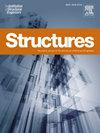Seismic collapse risk and performance factors assessment of RC dual lateral load-resisting system under far- and near-fault earthquake conditions
IF 4.3
2区 工程技术
Q1 ENGINEERING, CIVIL
引用次数: 0
Abstract
This paper investigates the seismic collapse risk and performance factors of typical reinforced concrete (RC) buildings with a dual lateral load-resisting system, incorporating moment-resisting frames and shear walls, using the FEMA P-695 methodology. To achieve this, Six buildings, ranging from four to thirty stories, were designed in compliance with ASCE/SEI 7-16 and ACI 318-14 standards using the response spectrum method. Validated finite element models were developed in the OpenSees software to conduct nonlinear static and dynamic analyses, incorporating far- and near-field ground motion records as recommended by FEMA P-695. Key performance metrics, including maximum and residual inter-story drift ratios, collapse fragility curves, seismic performance factors, and collapse risk, were evaluated. The study revealed significant discrepancies between observed performance and current design standards for dual RC shear wall buildings. Notably, the overstrength factors for short-period and long-period performance groups (3.12 and 1.29 respectively) deviated from ASCE/SEI 7-16 standard values, with both overstrength and period-based ductility factors decreasing as building height increased. Despite adherence to ASCE/SEI 7-16 requirements, these buildings exhibited substantial collapse risks under both types of ground motion. Near-field conditions were particularly concerning, with collapse probabilities over a 50-year period ranging from 4.5% to 10.1%, significantly exceeding the 1% target. These findings highlight the need for refined seismic design approaches for RC shear wall buildings to improve performance across various seismic scenarios.
远、近断层地震条件下RC双侧抗荷载体系地震倒塌风险及性能因素评估
本文采用FEMA P-695方法,研究了典型的钢筋混凝土(RC)建筑的地震倒塌风险和性能因素,该建筑具有双侧抗荷载系统,包括抗弯矩框架和剪力墙。为了实现这一目标,使用响应谱法,按照ASCE/SEI 7-16和ACI 318-14标准设计了六座建筑,从4层到30层不等。在OpenSees软件中开发了经过验证的有限元模型,以进行非线性静态和动态分析,并结合FEMA P-695建议的远场和近场地面运动记录。关键性能指标,包括最大和剩余层间漂移比,倒塌脆弱性曲线,抗震性能因素和倒塌风险进行了评估。该研究揭示了观察到的性能与当前双剪力墙建筑设计标准之间的显著差异。值得注意的是,短周期和长周期性能组的超强系数(分别为3.12和1.29)偏离ASCE/SEI 7-16标准值,且随着建筑高度的增加,超强系数和周期延性系数均降低。尽管符合ASCE/SEI 7-16的要求,这些建筑物在两种类型的地面运动下都有很大的倒塌风险。近场条件尤其令人担忧,50年期间的崩溃概率在4.5%至10.1%之间,大大超过了1%的目标。这些发现突出表明,需要改进钢筋混凝土剪力墙建筑的抗震设计方法,以提高其在各种地震情况下的性能。
本文章由计算机程序翻译,如有差异,请以英文原文为准。
求助全文
约1分钟内获得全文
求助全文
来源期刊

Structures
Engineering-Architecture
CiteScore
5.70
自引率
17.10%
发文量
1187
期刊介绍:
Structures aims to publish internationally-leading research across the full breadth of structural engineering. Papers for Structures are particularly welcome in which high-quality research will benefit from wide readership of academics and practitioners such that not only high citation rates but also tangible industrial-related pathways to impact are achieved.
 求助内容:
求助内容: 应助结果提醒方式:
应助结果提醒方式:


